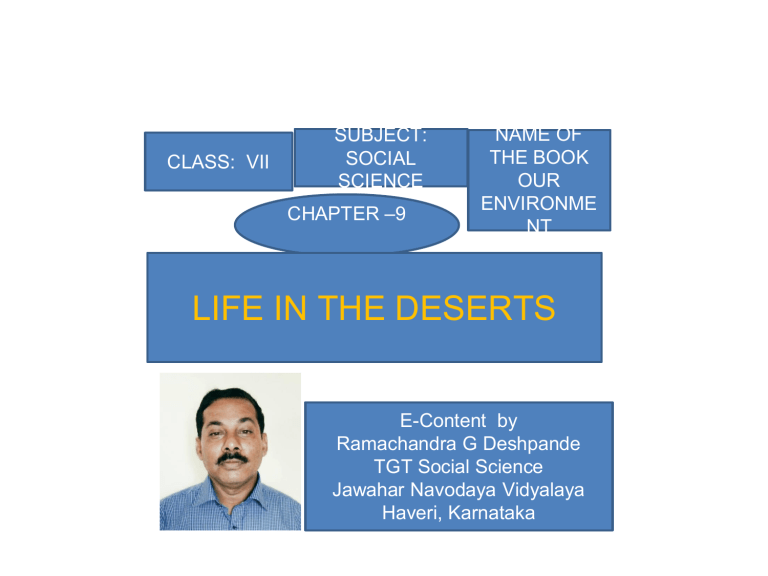
CLASS: VII SUBJECT: SOCIAL SCIENCE CHAPTER –9 NAME OF THE BOOK OUR ENVIRONME NT LIFE IN THE DESERTS E-Content by Ramachandra G Deshpande TGT Social Science Jawahar Navodaya Vidyalaya Haveri, Karnataka OBJECTIVES • After the completion of this chapter the students will be able to • Differentiate the climate ,flora and Fauna of Cold desert and Hot Deserts • Identify and locate Cold and Hot Deserts on the outline map of the world. • Identify the characteristics of Desert areas. Life in the deserts • Introduction: In the 5th Chapter you studied about water and its importance. It is difficult for everyone to live in places where there is no water to drink, where there is no grass for their cattle to feed and where there is no water to help the crops to grow. • Today, we learn about the places as hot as fire and some as cold as ice Desert • Now you will be easily identify by seeing the picture i.e. Desert. • Meaning: It is an arid region characterized by extremely high or low temperature and has scarce vegetation. Identify the picture Characteristics of the Deserts • 1. Low Rainfall • 2. Scanty Vegetation. • 3. Extreme temperature • Two types of Deserts • 1. Cold Desert. • 2. Hot Desert Types of Deserts Hot desert • The Sahara Desert Location In which continent Sahara Desert is located. Sahara desert In which part of Africa Sahara desert is located Interesting facts about Sahara Desert 1. It has an area of around 8.54 Million sq. Km.( India has an area of 3.28 Million sq. km.) 2. It is the largest desert in the world. 3. The highest temperature recorded in Al Azizia in Sahara. 4. Sahara touches eleven countries Identification of 11 countries • Algeria • Chad • Egypt. • Libya. • Mali • Mauritania • Morocco • Niger • Sudan • Tunasia • Western Sahara fact about Sahara • The present day sahara once used to be a lush green plain. Cave paintings in Sahara desert show that there used to be rivers with crocodiles, Elephants, Lions, giraffes,Ostriches, Sheep, Cattle and goats, were common animals. But the change in climate has changed it into a very hot and dry region. Climate of Sahara • 1. Scorching hot and parch dry. • 2. Sky is cloudless and clear. • 3. The Moisture evaporates faster than it accumulates. • 4. Days are unbelievably hot. • 5. The temperature during the day bare rocks, which in turn radiates heat making everything around hot. • 6. The nights may be freezing cold with temperatures nearing zero degrees. Flora and Fauna • Vegetation in Sahara includes• Cactus, Date palms and Acacia Animals found in the Sahara • Camels • Hyenas • Jackals Prominent animal species • Foxes • Scorpions • Varieties of snakes • Lizards OASIS • In some places there are oasis. • Meaning: A fertile land in a desert where water is found. • Formation: Depressions are formed when the wind blows away the sands. In the depressions where underground water reaches the surface an oasis is formed. People • Despite of harsh climate various groups of people inhabited in the Sahara Desert. • They are: • Bedounis • Tuaregs. Bedounis and Tuaregs • These groups are nomadic tribes rearing livestock's such as goats, sheep, camels and horses • These animals will provide them with meat, milk and hides. • They prepare belts, slippers, water bottles, Products prepared • Hair is used for mats , carpets, clothes and blankets. • They wear heavy robes as protection against dust storms and hot winds. Crops grown by the people of • The oasis in the Sahara and the Nile Sahara Valley in the Egypt supports settled population. • The people grow crops like: Rice, Wheat, Barely, and beans also. • They grow cotton also. Egyptian cotton is famous in the world. Discovery of oil. • A discovery of oil- a product in great demand throughout the world, in Algeria, Libya and Egypt is constantly transforming in the Sahara desert. Minerals found in Mauritoni Africa. • Iron a • Phosphorous. Nigeria • Crud oil Libya • Uranium. Niger Change of cultural land scape of Africa • The cultural land scape of Sahara is • undergoing change. • Gleaming glass • ceased office buildings tower over mosques and super highways crisscross the ancient camel paths. • Trucks are replacing camels in the salt trade. Tuaregs are seen acting as guides to foreign tourists. More and more nomadic herdsmen are taking to city life finding jobs in oil and gas operation. THE COLD DESERT LADAKH THE COLD DESERT • Ladakh is the LADAKH cold desert lying • Ladakh is also in the Great known as Himalayas • “Khapachan” • Meaning of which means Ladakh: It is “Snow Land” made up of Two letters • “ LA” means mountain pass. • “DAK” means country. In which continent Ladakh is situated Asia India LOCATION OF LADAKH. Location and boundaries of Ladakh • It is lying in the great Himalayas on the eastern side of Jammu and Kashmir. • Boundaries: The Karakorum range in the north. • The Zanskar Mountains in the south Boundaries • It extends from Siachen glacier in the Karakoram range to the north to the main great Himalayas to the south • The eastern end of Ladakh Aksai chin plains under Chinese control Rivers • Several rivers flow through Ladakh . • Indus being the most important among them. • Shyok and Nubra are other rivers • The rivers form deep valleys and gorges. A narrow valley with steep slides and river running through it. Glaciers Meaning: The mass of ice moves slowly down a valley. Several glaciers are found in Ladakh. for Example the Gangri glacier Climate of Ladakh • The air at this altitude is • The altitude in so thin that the heat of the Ladakh varies from sun can be felt intensely about 3000m in Kargil to more than 8000 m in Karakoram. • Due to its high altitude, the climate is extremely cold and dry. Climate • The day temperatures in summer are just above zero degree and the night temperatures well below -30*C. • It is freezing cold in the winters when the temperatures may remain below -40* for most of the time. Rainfall • You will be • As it lies in the surprised to know rain shadow of that if you sit in Himalayas, there s the sun with your little rainfall . feet in the shade, • It gets as low as you may suffer 10 cm every year. both sunstroke and frost bite at • The area the same time. experiences freezing winds and burning hot sunlight. Flora and Fauna • 1. Due to high aridity, the vegetation is sparse. • 2. There are scanty patches of grasses and shrubs for animals to graze. • Groves of willows and poplars are seen in the valleys. Preparation of Cricket bats • The finest cricket bats are made from the wood of the willow trees Fruits grown in Ladakh During the summers , some fruit trees grows. such as 1.Apples, 2) Apricots and 3) Walnuts. • We will find different type of birds in Ladakh • 1 Hoopoe • 2. Raven • 3. Robin Species of birds. Birds • Redstarts • Tibetan snow cock Animals of Ladakh • The animals of Ladakh are: 1) Wild Goats • 2.) Wild Sheep • 3)Yak 4) Special kinds of dogs • Animals reared to provide for the milk, meat and hides. • Yak’s milk is used to make cheese and butter. • The hair of the sheep and goat is used to make woolens. Endangered species • The chiru or the Tibetan Antelope is an endangered species. • It is hunted for its wool Known as “Shahtoosh” • Which is light in weight and extremely warm. Cultivation of crops • In the summer season the people are busy in cultivating – • Barely,Potatoes peas, beans, and turnip • The Climate in winter months is so harsh that people keep themselves engaged in festivities and Drass , one of the coldest ceremonies. inhabited places on the earth is located in Ladakh Climate of Ladakh Leh • Leh is the capital of Ladakh is well connected both by road and air. • The National Highway 1A connects Leh to Kashmir Valley through the Zoji la Pass. Leh highway crosses four • Rohtang la passes. • Baralacha la • Lungalacha la • Tangland la. • The high way opens only between July and September when snow is cleared from the road. Life of the people • Life of the people is undergoing change due to modernization. • But the people of Ladakh have over the centuries learned to live in balance and harmony with nature. They are using resources like water and fuel with reverence and care. Nothing is wasted. Women at work • The women are very hardworking. They work not only in the house and field, but also manage small business and shops. People of Ladakh • The people here are either Muslims or Buddhists. • The main religious groups are Muslims 46%. Tibetan Buddhists 40%, Hindus 12% and others 2% . • Several Buddhists monasteries are there in Ladakh. • Their traditional monasteries called Gompas. Famous Monasteries • Hemis. • Thiksey. • Shey. • Lamayuru. Tourism The govt. of India encouraged tourism in Ladakh • Tourism is a major activity with several tourists streaming in from within India and abroad. • Visits to the gompas, treks to Buddhist monasteries see the meadows found in Ladakh are called GOMPAS and glaciers. FESTIVALS AND • Ladakh people CEREMONIES Witnessing several ceremonies and activities. THANK YOU ALL ACKNOWLEDGEMENTS: Credits to all those who have provided images freely without royalty. E-Content by Ramachandra G Deshpande TGT Social Science Jawahar Navodaya Vidyalaya Haveri, Karnataka





